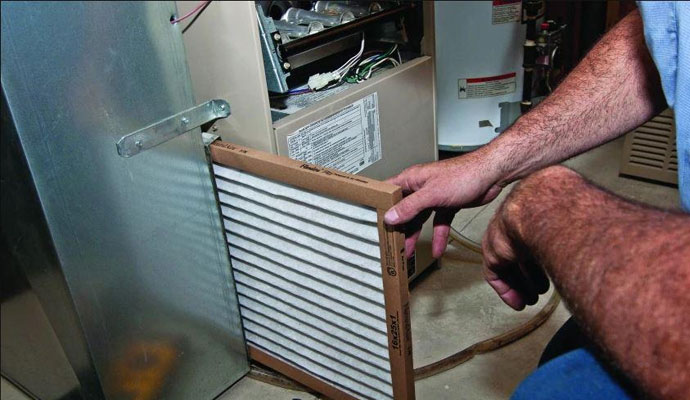Maintaining your home’s furnace is essential for ensuring that your heating system runs smoothly, efficiently, and cleanly. One of the simplest yet most crucial tasks in furnace maintenance is regularly replacing the furnace filter. However, many homeowners wonder, “How often should I change my furnace filter?” The answer depends on several factors, including the type of filter, the size of your home, and specific household conditions like pets, allergies, or air quality concerns.
In this blog, we’ll dive into the details of when you should replace your furnace filter and why it’s important for your HVAC system’s performance and your overall indoor air quality.
Why Is It Important to Replace Your Furnace Filter?
Before discussing the right timing, let’s understand why it’s so important to change your furnace filter regularly. The furnace filter plays a vital role in:
- Air Quality: The filter traps dust, dirt, and other particles, ensuring that the air circulating in your home is clean. A dirty filter can cause particles to enter your home’s air supply, leading to respiratory issues or allergies.
- System Efficiency: A clogged filter forces your furnace to work harder to push air through, reducing the system’s efficiency and potentially increasing your energy bills.
- Furnace Longevity: When the furnace has to work harder due to a dirty filter, it can lead to overheating and unnecessary wear and tear, shortening the lifespan of the unit.
How Often Should You Replace Your Furnace Filter?
The frequency of replacing your furnace filter depends on several factors, including the type of filter and specific environmental conditions. Let’s break it down:
1. Standard Disposable Filters (Fiberglass)
- Frequency: Every 1-3 months
- Reason: These are the most common and affordable furnace filters, but they tend to clog quickly. If you have no pets or allergies and live in a small home, you can go as long as 90 days. However, for larger homes, high usage, or homes with pets, replacing the filter every month is best.
2. Pleated Filters
- Frequency: Every 3-6 months
- Reason: Pleated filters are made from higher-quality materials and capture more particles than standard filters. However, this also means they collect dirt faster. These filters are a good option for households with pets or people who suffer from allergies.
3. High-Efficiency Filters (HEPA)
- Frequency: Every 6-12 months
- Reason: HEPA filters offer superior filtration and are typically found in homes where individuals have severe allergies or respiratory issues. Because they trap smaller particles, they last longer than standard filters. However, they should still be checked regularly for dirt and blockages.
Factors That Affect How Often You Should Change Your Furnace Filter
Beyond the type of filter, several environmental and household factors will affect how frequently you need to change your filter:
- Pets: Homes with one or more pets should consider changing the filter more often, around every 1-2 months. Pet hair and dander clog filters more quickly.
- Allergies or Asthma: If anyone in your home suffers from allergies or asthma, change the filter every 1-2 months to ensure optimal air quality.
- Size of Home: Larger homes generally require more frequent filter changes due to the larger volume of air being circulated.
- Seasonality: During peak usage times (winter for heating and summer for air conditioning), you may need to replace the filter more often, especially if your furnace and air conditioner share the same duct system.
- Air Quality: If you live in an area with poor air quality (e.g., urban areas, near construction, or regions with frequent wildfires), filters will need to be replaced more often.
Signs That Your Furnace Filter Needs to Be Replaced
If you’re unsure whether it’s time to replace your filter, keep an eye out for these signs:
- Increased Energy Bills: A clogged filter makes your system work harder, which can lead to a noticeable increase in your energy bill.
- Dusty Home: If you notice more dust on your furniture or floating in the air, it may be a sign that your filter is full and no longer trapping particles effectively.
- Furnace Cycling On and Off: When the furnace can’t get enough airflow due to a dirty filter, it may overheat and shut off, only to restart after cooling down.
- Reduced Airflow: If less air is blowing through your vents, it could be due to a clogged filter that’s restricting airflow.
How to Replace a Furnace Filter
Replacing your furnace filter is a simple task that can be done in just a few steps:
- Turn off your furnace for safety.
- Locate the filter—usually found in the blower compartment, near the return air duct, or in the air handler.
- Remove the old filter and note its size (this is usually printed on the filter’s edge).
- Insert the new filter—make sure it’s installed with the correct airflow direction (this is indicated by an arrow on the filter).
- Turn the furnace back on and enjoy improved air quality and system performance.
Conclusion
Replacing your furnace filter regularly is a small maintenance task that can have a big impact on the efficiency and longevity of your furnace, as well as the air quality in your home. By following the guidelines above and considering your household’s unique needs, you can keep your furnace running smoothly and your home comfortable all year long.
Remember, clean filters equal clean air and energy savings!

